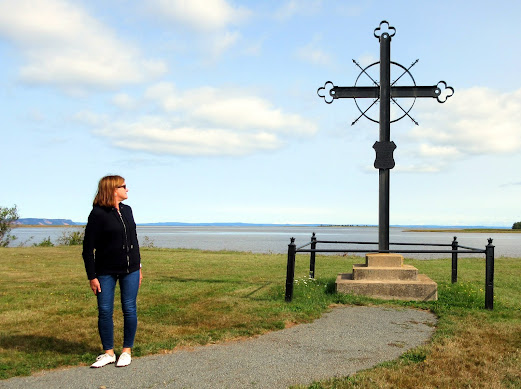"Acadia"
14 x 11", acrylic on mounted aluminium panel, 2021
painting #283
The Deportation Cross is located in Horton Landing Nova Scotia. It was conceived by René-Arthur Fréchette. In 1924, the gothic style cross was originally erected near a railway about a mile from the memorial church at the national historic site of Grand-Pré. In 2005, it was relocated to its current spot after archeologists determined and believed to be the exact location where the Acadians waited and boarded ships during the deportation of 1755.
This site along the Gaspereau River also includes the New England Planters Monument, dedicated to the settlers who took over the vacated land of Annapolis Valley between 1759 and 1768. A silvery ancient elm tree, believed to be 175 years old once stood only a few paces from the cross. The humongous tree was brought down during a powerful storm in November 2010. Years earlier, it had died from Dutch Elm disease and was bare of its bark and leaves. It had been hit by lightning a few times, still it stood and was admired for its resilience until the storm. Artists Alex Colville and Tom Forrestall both painted the tree while it was still alive. In the 1984 NFB documentary film, The Splendour of Order, Alex Colville mentions that it was believed that the tree had stood there since the deportation of the Acadians. Colville has also painted the deportation cross while it was at its original location. During the same documentary, the camera follows him while he makes his way to the cross, makes a preliminary drawing and takes measurements.
ALEX COLVILLE
"French Cross", 56.5 x 80 cm
acrylic on hardboard,
1988, private collection
My wife Suzanne, Sept. 2020
Cross at its current location, Horton Landing, NS.
This painting is infused with symbolism. The imagery that appears on the Barbours baking powder tin can is of the Evangeline Well and commemorative church at Grand-Pré. Making this a sister painting to my previous post. Barbours is a family owned business right here in New Brunswick. It's as old as Canada itself. It was founded in 1867 in Saint John, NB by George L. and William Barbour. It is renown for its spices, baking ingredients, tea blends and mostly for King Cole Orange Pekoe Tea which was introduced in 1910. The business relocated to Sussex, NB in 1966. Of course, baking powder is one of the ingredients used to make the dumplings in a hearty Acadian fricot.
The site of the cross now serves as a memorial. The small folding seat/table belonged to my late mother. She specifically bought it to attend an outdoor mass celebrated by Pope John Paul II in 1984 during his papal visit to Canada and stop in Moncton. The yellow dandelions represents the Acadians past and present that remained rooted on their homeland. The dandelion globes, much like when a gust of wind breaks and separated the sphere, then spreads the seeds everywhere, represent the Acadians that against their will were deported mostly back to France and along the seaboard of the13 American Colonies.
This is actually the second time I paint the Deporation Cross. The first time was in 2008 with my painting, "Reflecting on Being Acadian" when I painted Clive Doucet brilliant biographical book, Notes from Exile, featuring Alex Colville's "French Cross" on the book's jacket cover. Click HERE to view.
This painting will be part of a small solo show entitled "Art-ifacts", hosted by the Fog Forest Gallery in Sackville, NB from October 14 to November 5, 2021.
Unfortunately, in order for the gallery to remain open during the pandemic while keeping everybody safe, the gallery director and I came to the decision that it was safer not to hold an opening reception. The public however will be able to visit the gallery at their leisure during the run of the exhibition. The gallery is open on Thursday and Friday from 10 am - 5 pm. or by appointment.
14 Bridge Street, Sackville,New Brunswick, Canada, E4L 3N5Phone (506) 536-9000e-mail: janet@fogforstgallery.ca-SOLD
e-mail: janet@fogforstgallery.ca
-SOLD



